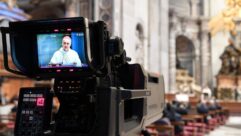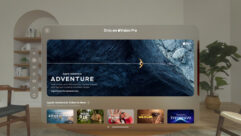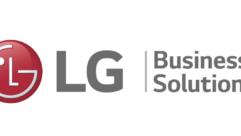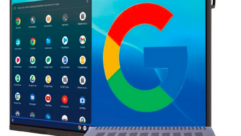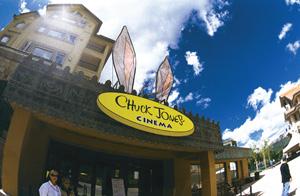

Into Thin Air
Set at 8,750 feet above seal level, high-profile film festival has experienced frequent projector burnout because thin atmosphere hinders bulb cooling.
The Chuck Jones Cinema, a converted conference room that seats 500 people during the festival, is one of the seven venues that housed temporarily installed digital projectors at this year’s Telluride Film Festival.
CHALLENGE:
Set at 8,750 feet above seal level, high-profile film festival has experienced frequent projector burnout because thin atmosphere hinders bulb cooling.
SOLUTION: Employ projectors with an increased fan-speed setting specifically designed for high-altitude conditions.
The Digital Cinema Initiative continues down its long, winding path, with the rollout of next-generation projection technology at a theater near you still set for some unknowable future release date. But Panasonic Projector Systems Co. isn’t waiting around for the wide-scale adoption of digital cinema by the theatrical exhibition industry before it tries to tap into the film business.
For the last two years, Panasonic has been a sponsor of the Telluride Film Festival, providing the digital projectors used for the screenings at the weeklong business-to-business film-industry event.
Nestled between two 35mm film projectors is a Panasonic PT-DW7000U three-chip digital projector. Its highland setting doubles fan speeds in high-altitude conditions. UHM lamps, which don’t overheat or shut down, are used in lieu of xenon lamps.
Held annually around Labor Day in the eponymous high-altitude Colorado ski town, Telluride is a showcase for independent moviemakers. Notable directors showing off new films this year included Sean Penn, Werner Herzog, and Todd Haynes.
Telluride offers Panasonic a means of exposing its digital projection technology to film purists who, the company hopes, will go on to integrate it into both their professional and personal lives.
Indeed, beyond the high-end home theater opportunities that exist within a well-heeled market that appreciates high-quality movie playback, there are myriad applications
CLOSING IN
While the major Hollywood studios and their theatrical exhibition partners continue their drawn-out haggle over the standards and set-up costs associated with wide-scale rollout of digital cinema, a grassroots digital production movement within the film and TV businesses has already been firmly established.
With a 60-minute miniDV tape running a couple of dollars —compared to about $1,000 for just one minute of film stock, once processing is factored in — independent filmmakers, documentarians, and budget-minded TV producers have began to shun celluloid in mass in recent years.
Canadian adventurer/filmmaker Les Stroud — whose solo sojourns into the rugged outback are chronicled on the Discovery Channel series “Survivorman” — says it would be nearly impossible to self-chronicle his harrowing wilderness journeys if not for economy of digital filmmaking.
Venturing alone into places like the Kalahari Desert, Stroud is acts as his own film crew, setting up an array of Sony digital cameras (the Sony HVR-Z1U is his workhorse) and just letting them roll — a technique that would be rendered prohibitively expensive if he were shooting on film.
“Tape is 10 bucks a shot, so I just keep the camera’s rolling,” Stroud says, noting that the devices are on up to 22 hours a day.
Meanwhile, the cost for digital cameras is far less than that for 35mm film, allowing Stroud to take his equipment into the moisture of the Amazon without bankrupting his modest production.
“Cameras have almost become disposable to me,” he says, noting that his recent Amazon excursion was so rugged and wet, he ended production with only one of five Sony cameras still working.
in Hollywood for digital projectors these days, as studios and filmmakers cede more and more of their production and editing to digital processes. Revenues from the “e-cinema” market —the business-to-business film-industry market that doesn’t involve theatrical exhibition — still only occupies a niche within the larger rental-and-staging market, Panasonic says. But it nonetheless sees film-makers as a constituency worth courting.
TEMPORARY VENUES
The town of Telluride only has one movie house, but each year fest organizers improvise screening rooms within places such as local high school gyms, an opera house, and an outdoor theater. This year, Panasonic sent three technicians to integrate four 6,000-lumen PT-DW7000U and three 10,000-lumen PT-DW10000U DLP-based projectors into seven of the fest’s nine screening facilities.
“Any time we get involved in a film event like Telluride, what we’re trying to do is show the directors and some of the key studio decision-makers the benefits of using digital projectors over traditional 35mm film projectors,” explains Tom Zitelli, president of Panasonic Projector Systems Co.“It’s almost like a seeding program. We understand that if we can show the benefits of these projectors — the portability, the brightness — we can leverage that somewhere in the future.” Telluride, of course, gets something out of the deal, too.
For his part, Jim Bedford — who has overseen operations for Telluride for the past 35 years — has more immediate challenges to overcome.
FILM FEST OR DIGITAL FEST?
While 80 percent of the 20 to 25 movies the festival screens each year are presented on film, increasingly of late, Telluride’s constituency of independent filmmakers is embracing relatively inexpensive digital production technologies. In other words, they are showing up at the festival with digital files, not film reels.
“These last seven or eight years we’ve watched [digitally shot films] take over more and more of our programming,” says Bedford, owner of the town’s sole year-round movie house, the Nugget Theater.
The ability to let indie filmmakers show their wares without having to bear the expense of converting them to film has significantly opened up the field of movie programming Telluride can offer its attendees.
Point and Click
- BenQ
www.benq.com - Digital Cinema Iniative
www. dcimovies.com - Panasonic
www.panasonic.com - Sanyo
www.sanyo.com - Telluride Film Festival
www.telluridefilmfestival.com
“Film is a very expensive medium, and the people who can afford to shoot in it form a very exclusive club,” explains Panasonic engineering manager John Meehan. “Being able to project in digital opens the floor up to a lot of talented independent filmmakers who may not have the resources to shoot on film.”
In lieu of mounting, the festival simply places the Panasonic DLPs on tables and can easily move them aside for a film presentation. The devices also connect quickly and easily to the variety of sound systems used in the nine screening facilities.
QUICK BURN
The festival had tried a number of digital projection solutions using xenon-powered lamps before successfully partnering with Panasonic in 2006. However, the event’s geographical location caused some interesting technical problems.
ALTITUDE ADJUSTMENT
Credit: BenQ
A Rocky Mountain ski resort isn’t the kind of place you’d typically associate with rampant lamp overheating.
But set in the middle portion of the troposphere, 8,750 feet above sea level, Telluride poses a challenging projection environment, with atmospheric pressure dropping nearly a quarter from the 14.7 pounds per square inch experienced at sea level.
Simply put, that means there’s less air available for the projector fan to blow past the lamp.
“The altitude has been a real issue for us in the past,” notes Telluride Film Festival operations director Jim Bedford, who has over the years improvised solutions such as widening projector vents in an effort to get more air molecules past super-heated bulbs.
However, a number of DLP projector manufacturers now integrate special high-altitude settings into their products. These modes —referred to as “highland” by Japanese manufacturers including Panasonic and Sanyo — increase the fan speed of the projector to make up for the decrease in atmospheric pressure.
BenQ, for example, recommends that the high-altitude setting on its MP510 model be employed at an elevation of 5,000 feet or more, or when the ambient temperature rises above 40 C.
The mode — which can be switched on via the projector’s advanced settings menu — must be used judiciously, the manufacturer notes. It will not provide sufficient cooling beyond a combination of 10,000 feet in elevation and an ambient temperature of 23 C (73.4 F). Conversely, the high-altitude setting should not be used under 5,000 feet, otherwise the projector’s lamp will be too cool to perform properly.
It should be noted that these variables differ from product to product — for its W100 home entertainment projector, for example, BenQ recommends switching to high-altitude mode at an elevation of only 3,000 feet.
“Because our festival takes place at 8,750 feet above sea level, there’s not a lot of molecules of atmosphere available, and you need to run a lot more air past the projector bulbs in order to cool them,” Bradford explains. “And we had so many problems with projectors burning out in the past that we used to put buckets of ice underneath the machines.”
“When we arrived, they had this big, professional [digital] projector hanging from the ceiling that did just nothing for them because they couldn’t get it to light,” adds Meehan, noting that the device had no means of cooling its lamp at high altitude. “I mean, you’re really up there in the upper atmosphere — you can feel it.”
Both of the Panasonic projectors include “highland” settings that double their fan speeds in high-altitude conditions. Each also includes UHM lamps en lieu of xenon. The PT-DW10000U uses four 250-watt UHM lamps, Meehan points out, “that work remarkably well, and don’t overheat and shut down.”
Most important to Bedford, however, is that Telluride’s cinemaphile audiences accept the level of projector performance. “We’re finding that audiences are more accepting of digital these days. I would be willing to bet that 80 percent of our audience isn’t aware as to whether the presentation they’re seeing is film or digital projection,” he says. “They talk about the content of the film, not whether it was shown in film or digital.”
While his own movie exhibition house still relies on film for most film presentations, Bedford purchased a PT-DW5000 last year for the purpose of alternative programming. The digital projector is available, for example, if someone rents out the establishment for a presentation, or if an indie filmmaker wants to screen his or her latest digital offering.
“We wanted to put more lumens on the screen, so we just upgraded to the [PT-DW7000U] projector. We got it and the lens for under $10,000,” adds Bedford, who estimates that 10 percent of the Nugget’s revenue now comes from so-called “alternative” digital presentations.
“I’m not entirely happy that film is going away,” he adds. “But if we can give our audience a better, clearer picture with fewer scratches and great sound, I’m for that.”
Daniel Frankel is a Los Angeles–based freelance writer. He can be reached at [email protected].



